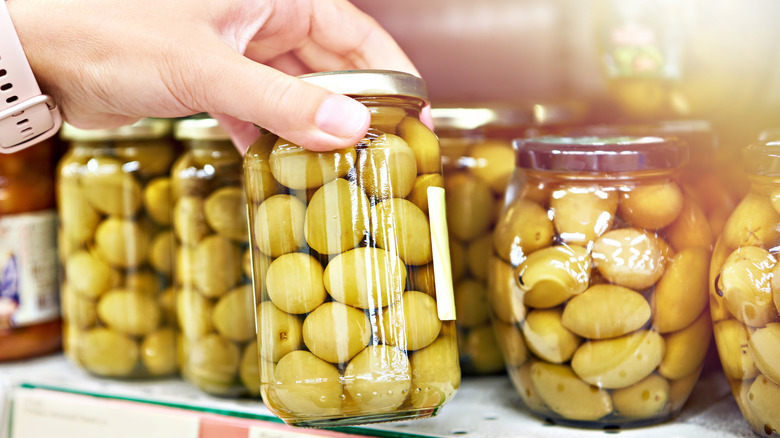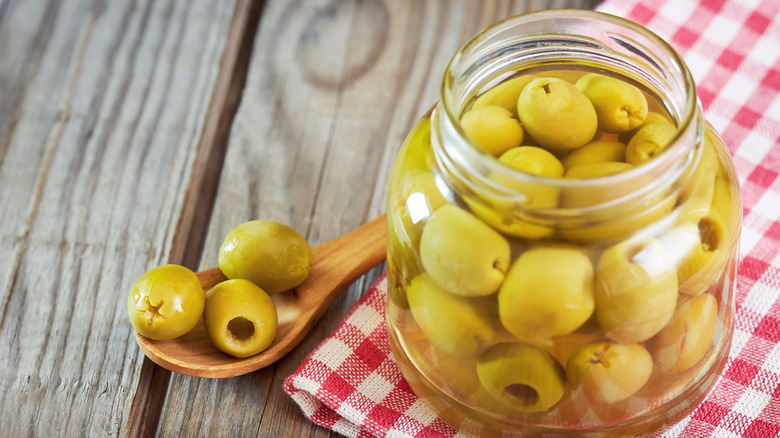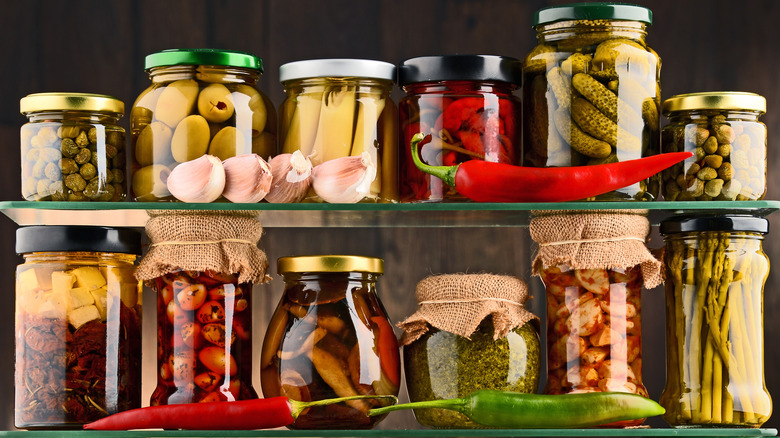What's The Shelf Life Of An Unopened Jar Of Olives?
Olives are one of the most versatile and long-lasting kitchen staples around. Commercially-packaged olives are preserved in brine, which contributes to their long shelf life. This brine usually consists of salt, vinegar, and water, depending on the brand, in addition to various flavorings. Both salt and vinegar inhibit microbial growth, keeping the olives fresh and free of illness-causing bacteria. According to Food Safety, these small fruits can last for 12 to 18 months in the pantry if left unopened, but once you've opened the jar or can, you must refrigerate and eat them within two weeks.
To know when your particular jar of olives will expire, you can judge by the best-by date on the jar, but that's more of a guideline than a rule. Expiration dates indicate how long a food product will retain its best flavor, texture, and nutritional values, and usually have little to do with when the food will become unsafe to eat. Even if the expiration date on your olives is only five or eight months away, the olives should last for a year or more, as long as the jar remains sealed.
That being said, sometimes you're out of luck and your jar of olives becomes compromised, either before or after opening. Here's how to tell when olives have actually gone bad, plus tips on how to store them and use them up in time.
How to tell if olives have gone bad
Jarred olives and other groceries have surprisingly long shelf lives, but can still go bad over time. The first thing you should do after finding an old jar of olives in your pantry is to check it for cracks or other signs of damage on the container itself. The lid on the jar should be intact, with no rust, dents, or bulges. Physical damage to the lid or glass can allow air and bacteria to enter the jar, resulting in spoilage. The same goes for cans of olives — bulging indicates bacterial infection.
If the jar itself looks good, unseal it jar inspect its contents. Firstly, make sure there is no mold. You may notice a white film on top of the olives, but that's not mold or mildew. What you're seeing is the probiotic bacteria that forms during fermentation. It's perfectly edible, so you can leave it in the jar, and even rinse it off before eating, if it bothers you. However, specks of any other color mean it's time to toss the olives out.
Aside from this obvious sign of spoilage, the olives themselves should have a firm texture and a pleasant, briny smell. If they feel mushy or slimy, it's a sign that they may have gone bad. Discard them if you notice any foul odors, unusual color changes or inconsistencies, or significant changes in their size or texture, such as shrinkage.
There's a right way to store jarred olives
Store unopened canned or jarred olives in a cool, dry place, such as your pantry or basement. Don't put them next to a window or on the kitchen counter, because exposure to sunlight can cause them to deteriorate faster. The same can happen if you keep the jar close to the stovetop or other heat sources — you want an area with a consistent, cool temperature.
After opening the jar, transfer it to the refrigerator and eat the olives within 14 days. Keep them in their brine to prevent microbial growth and keep them moist. Remember that salt acts as a preservative and may help delay spoilage. Close the lid tightly after each use, and always use clean utensils to take the olives out of their jar. You don't want to accidentally expose them to bacteria from other foods, or even your hands.
If you have a large jar of olives, there are many ways to use them up. For example, you could turn them into a luxurious snack by heating them up in olive oil. Add fresh herbs, garlic, and lime or lemon zest for extra flavor, and enjoy with bread. Alternatively, mix your olives into salads or cooked dishes, like this chicken frittata that's just perfect for lunch or dinner. And nothing uses up leftover olives more quickly than a big cheese board to share with a crowd.


